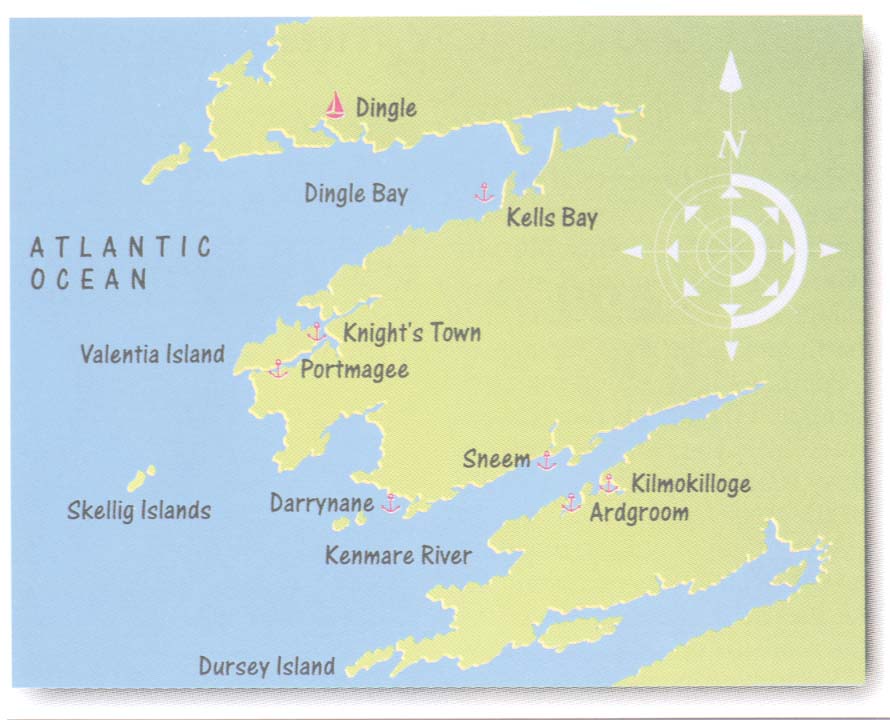
Cruising The Emerald Isle
The West and South Coasts of Ireland
By Thom Burns
 |
The massive amount of literature from Ireland lends to each of us, whether we are of Celtic origin or not, one or more connections to this legendary island. It is the home of saints, sinners, singers, fishermen and sailors. The south and west coasts of Ireland are a treasure for European and British cruisers. The problem for these nearby cruisers is according to British author, John Leonard, the open waters of the Celtic Sea or the shorter tideswept routes across St. George's Channel can present an intimidating choice. "But for a competent skipper in a seaworthy boat a passage to Ireland should be considered with respect, not fear."
The opportunistic benefit to the Breagan crew was that we planned the North Atlantic crossing (see Sep/Oct 2000 issue) so that we landed on the west coast and took full advantage of the prevailing westerly winds while subsequently cruising the west and south coasts from Dingle Bay to Kinsale. The west coast greets you with a richness of seascapes almost beyond adequate description. Initially it is incredibly rugged with mile after mile of sequential displays of raw, natural beauty interspersed with tiny, quaint villages and thousand or more year old relics of the past. Then the cliffs blend towards the water and you are treated to perfectly manicured farm fields with tens of shades of green. Each field separated by stone fences or hedgerows. Often the hedgerows which also commonly make-up roadside flowers seemed like an endless display of spectacular hanging baskets without the baskets.
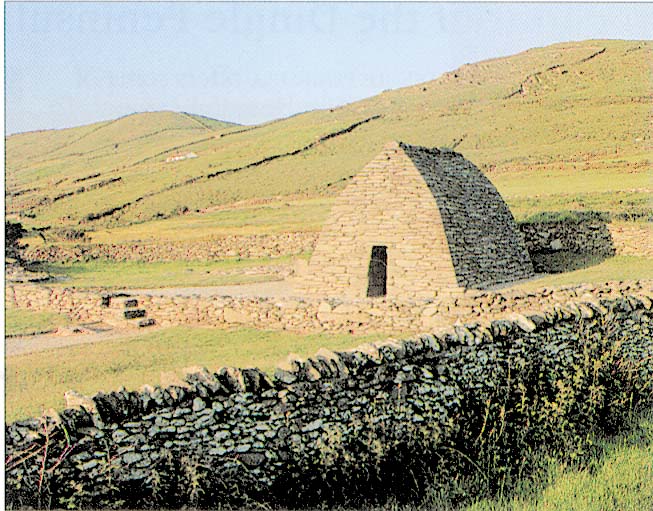 |
| Gallarus Oratory, a dry-stone early Christian church |
Dingle, our arrival port, is an engaging base for exploring the Dingle Peninsula. It is also loaded with services, good food, music and pubs. We had a special treat in that we met an Irish couple, Michael and Ann, who were on holiday. They were invaluable in their tips and commraderie. We would see them several more times. People are a great treat in Ireland. Lt Cdr Brian Farrell, the harbor master, and the berthing master Johnny Murphy were a daily delight. It was great to see the kids enthusiastically sailing every day in their small boats from the sailing club. There were several other cruising boats in the harbor but no other Americans. After resting up for 4 days we set sail for
Darrynane.
When leaving Dingle you follow a long, narrow, dredged channel marked by a range until you are a short distance from the pristine fields of the peninsula. Then you make a sharp left on your first dogleg out of the bay. It was here that we met the most famous resident of Dingle, Fungie, the Dingle dolphin. Fungie took up residence in the harbor approaches in 1984 and has spawned a mini-industry of 'Dolphin Watching,' 'Swimming with the Dolphin', books, records, T-Shirts, and various reincarnations as a stuffed or plastic animal. Despite our recent and frequent encounters with dolphins, we were excited. Fungie puts on a good show. Once in Dingle Bay, the Slea Head Peninsula, leading out to the Blasket Islands, is a spectacular area of cliffs and mountains. The photogenic setting for David Lean's cinema classic Ryan's Daughter.
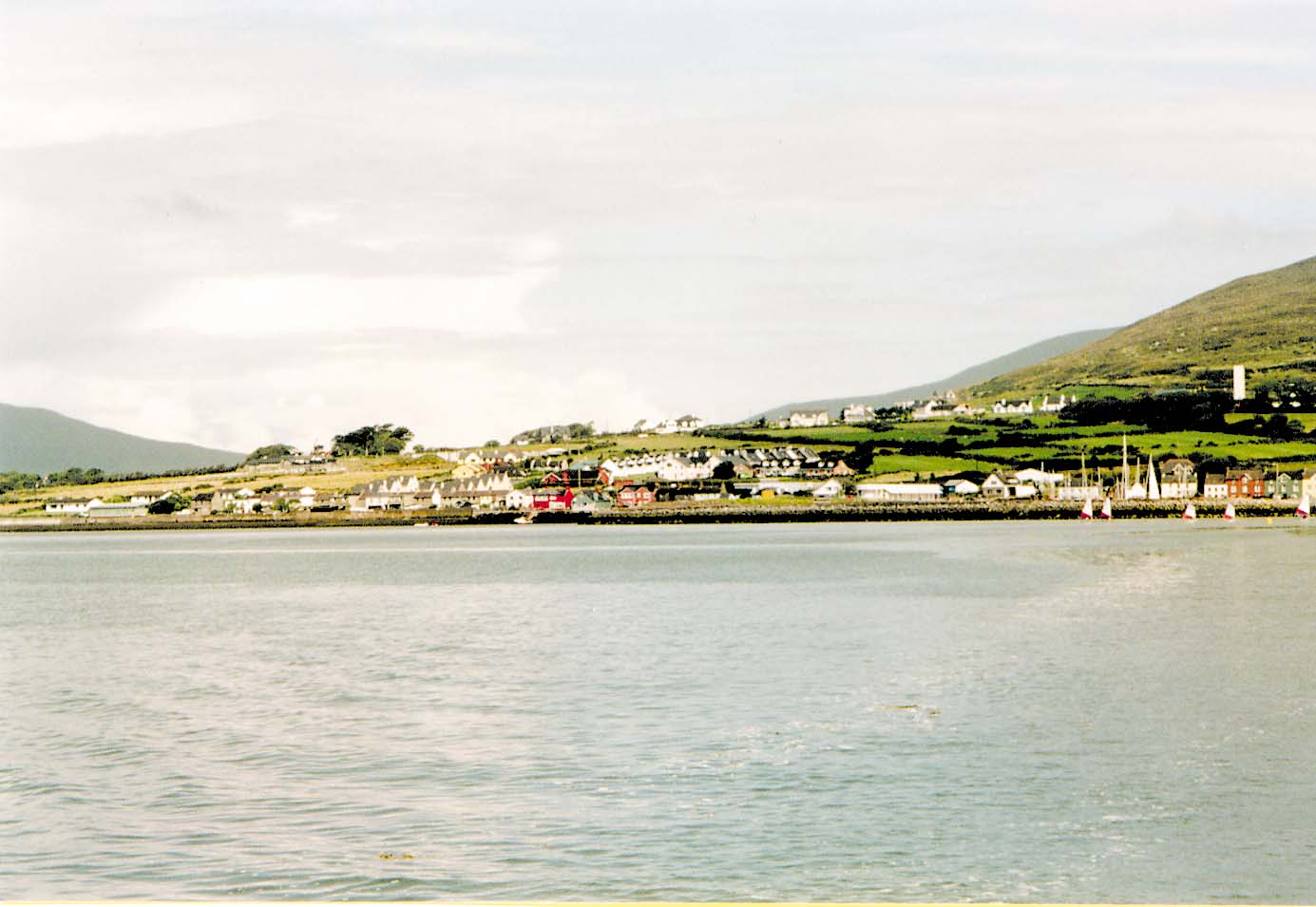 |
|
Leaving Dingle |
The Blaskets are a group of seven islands off the tip of the Dingle Peninsula. For centuries the islands were occupied by a community of peasant fisherfolk, eking out a living from the sea and by working the tiny artificial fields which they created by using seaweed gathered from the shore.
Starting with Tomas OíCrohanís The Islandman, several islanders wrote autobiographical accounts of their lives.
These books achieved worldwide interest for the uncompromising accounts of the harsh, remote peasant lifestyle and were translated into many languages, forming a special library which captured a unique society before it was lost forever.
By the 1950s the declining population could no longer support itself, the last remaining islanders moved across the Blasket Sound to the mainland village of
Dunquin.
The story of the islands can be discovered at the Blasket Islands Interpretative Center at Dunquin. Itís a local bus from Dingle and there is a good cafe!
We turned south away from the Blasket Islands and past Valentia Island which is home of the Irish Coast Guard. We then headed toward the Skellig Islands. They look like two miniature mountains rising from the sea. Between the 6th and 12th centuries Great Skellig or Skellig Michael was the home to an early christian community who survived on the almost 500 ft. bare rock by building beehive huts of stone. It is now one of Irelandís most important heritage sites. Although there is a small pier, it is only approachable during calm weather. It was not calm nor wild so Mike McGarry and I took a photo shoot from the dinghy with the Skelligs in the background. Little Skellig is a saw toothed, white smeared bird sanctuary with a phenomenal aviary population of gannetries and other birds.
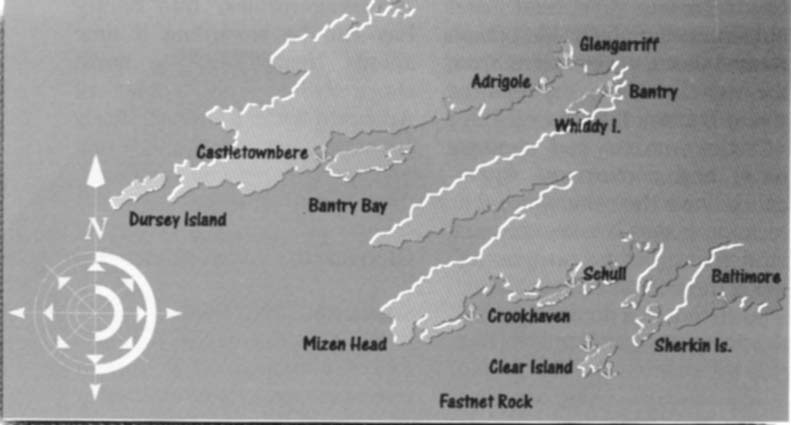 |
After our waterborne sightseeing of the Skelligs, we proceeded to Darrynane. This is a delightful place with a high intensity approach through outlying reefs and a dog leg through small short ranges to reach the haven within.
Mike proved to be one of the most agile bow jumpers around. The buoys are about three feet across with a ring in the middle. Neither of the remaining two had any mooring pennants. Mike hopped off the bow onto the buoy and passed a dock line through the eye and back to the crew on deck. In seconds we were secured in this manner.
Darrynane is a national park. We dinghied in to the sandy beach at high tide. It is backed by dunes and beautiful mountain scenery. Keatings Bar which is tiny is a short walk uphill from the beach. We made some friends or at least shared some pints and found our dinghy under a new moon a 100 feet from the water which was at low tide. With our new found fortitude we slid it down the beach so our skipper, Jack Mowry, could board without getting wet. Since we forgot flashlights, our fellow cruisers from Australia shined a spotlight on our boat so we could find it. I knew we would pay at least once for this night!
We left Darrynane enroute to a highly recommended destination, Bear Island in historic Bantry Bay. This was a great sailing day, warm, sunny moderate winds. We flew the spinnaker almost the entire way even while navigating on the range to Castletown and then jibing for the run down Bear Island to the quaint little harbor. Bear Island is one of those out of the way summer locations. It is one of the prettiest villages we saw. It was the weekend so we had plenty of opportunity to socialize. I walked into the village on Sunday morning and found it totally deserted until church let out. The entire village seemed to be walking back to town from the church on the hill. Since Bear Island is only accessible by boat or ferry it was noticeably quieter.
The next day we took a turn around Mizen Head past Crookhaven to the popular resort and sailing center of Schull. There is an large mooring field of privately owned yachts. The town is bright and lively in its decor and ambience. We spent some time poking around the bookshops and delis. The morning sun filtered through scattered clouds upon the fields as we departed this beautiful sailing center.
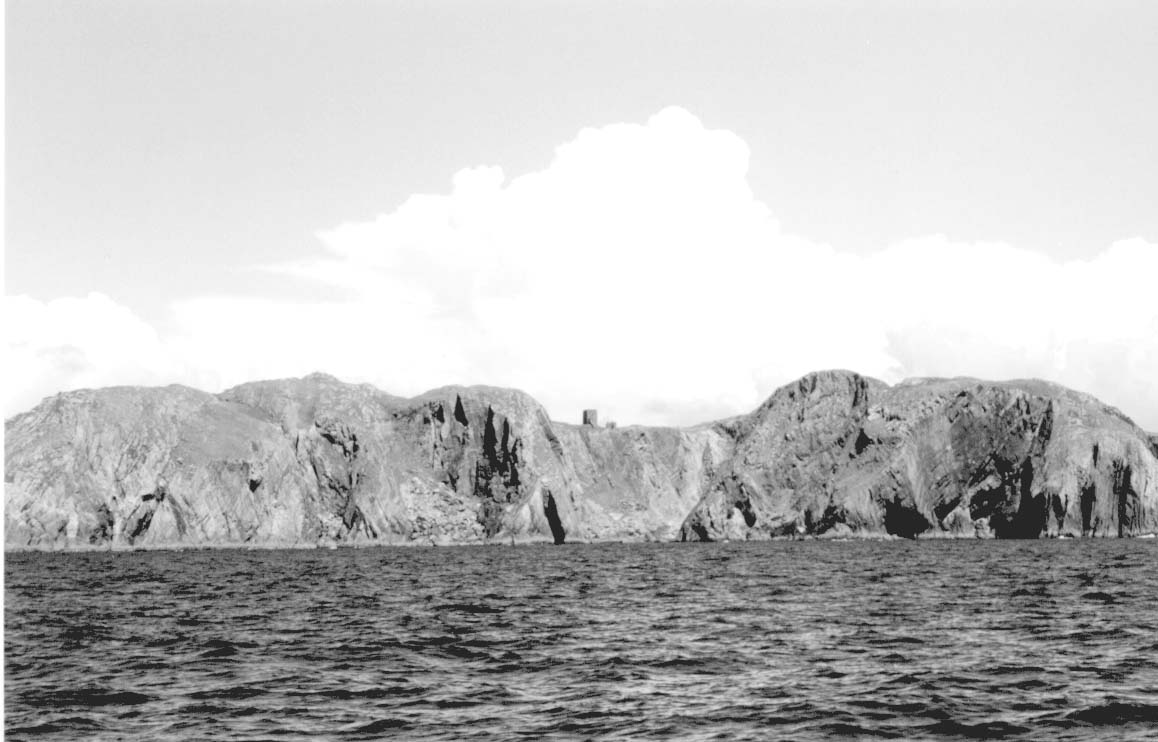 |
| The west coast is rugged with relics everywhere. |
The weather was forecast to get worse and we were concerned about getting Breagan to the Kinsale - Cork area, so we decided to sail for Kinsale about 70 nautical miles. We had to take a detour first around Fastnet Rock. Of course it rained and blew all the way out there and the autohelm quit. I made a temporary tiller extender and put it on the wheel so I could steer from under the dodger. We rounded the awesome rock and proceeded on to Kinsale. It was off and on showers all day as we checked off Baltimore, Castlehaven, Old Galley Head, Seven Heads and finally Old Head of Kinsale before proceeding to the Kinsale Yacht Club.
Kinsale Harbor is the deep, sheltered entrance to the Bandon River. The approach runs through a progressively narrow channel until it opens up with marinas and anchorage areas on both sides. The gentle run up to the marina is magnificent. It is dominated by the castle and defensive works on the starboard side. The town of Kinsale lies next to a large, natural pool which has sheltered shipping for centuries.
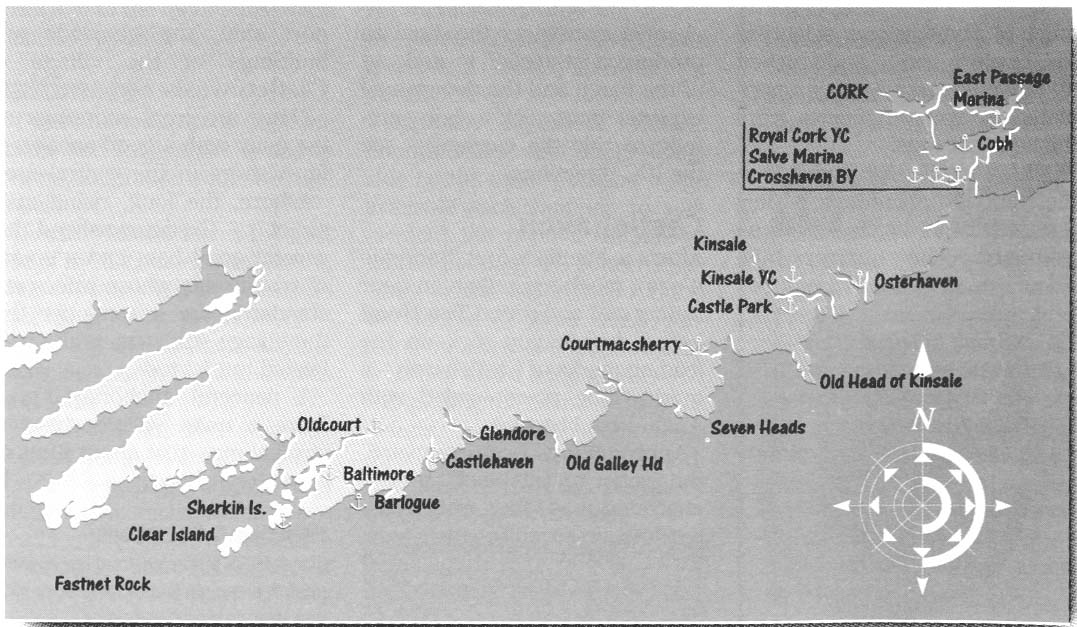 |
In 1601 Kinsale was the scene of a major uprising against the occupying English. A Spanish invasion fleet landed at the invitation of the Irish forces, but the English were victorious and a bloody massacre followed. If you have time hike the Old Head of Kinsale. Itís about five miles through small farms and a few tiny villages where you can find a pub or two to revive you before heading back. The views west toward Courtmacsherry and east towards Cork are magnificent.
About fifteen to twenty years ago local businesses made a serious effort to lift the profile of Kinsale and promote it as the ďGourmet CapitalĒ of Ireland. The result is a large number of seafood and European restaurants. Specifically, we thoroughly enjoyed Man Fridayís overlooking the harbor. Several of us recommend black sole with seafood stuffing. The Vintage Restaurant offers very fine Italian. Both restaurants had outstanding service. The Spaniard Inn is a great pub with good music.
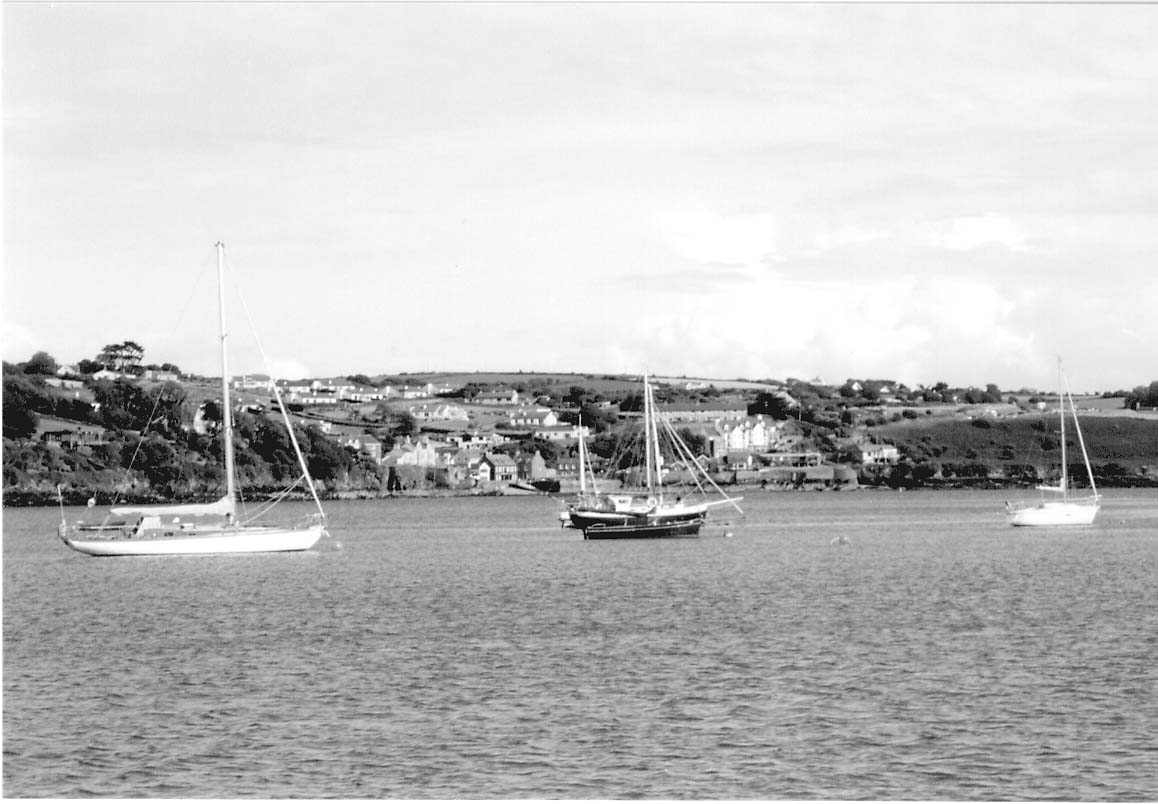 |
| Schull is a popular sailing destination and a pretty village. |
We met Michael and Ann for the third time on our trip in Kinsale. They were great. We shared music, a mutual interest in each otherís country, and an appreciation for the sea. We celebrated their last night of holiday together in
Kinsale.
I rented a car for a few days to run around the countryside and do errands for the final preparations for leaving the boat for the winter. After visiting Cork, Jack decided that Kinsale was a fine place to leave Breagan. The Yacht Club staff and marina folks in Kinsale were extremely helpful.
The west and south coast cruising of Ireland was a wonderful two hundred mile trip which capstoned the crossing of the North Atlantic. It would be an excellent stand alone sail for the adventurous sailor.
Thom Burns publishes Northern Breezes. Jack Mowry owns Breagan, a Norseman 400. Other crew on the cruise were Mike McGarry, Steve and Pat Burns.
For more info:
South And West Coasts of Ireland by Irish Cruising Club.
Sail Ireland Charters, Trident Hotel Marina, Kinsale, Co. Cork Tel +353 21 4772927 Fax 4774170.
www.sailingireland.com